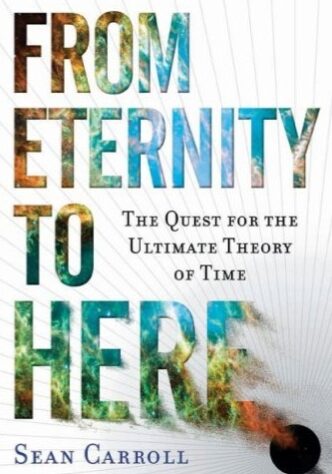From Eternity to Here
The Quest for the Ultimate Theory of Time
From Eternity to Here is a popular-level book on cosmology and the arrow of time, published by Dutton in January, 2010.
"For anyone who ever wondered about the nature of time and how it influences our universe, this book is a must read. It is beautifully written, lucid, and deep."
-- Kip Thorne, Feynman Professor of Theoretical Physics at Caltech and author of Black Holes and Time Warps: Einstein's Outrageous Legacy.
Buy it:
Indie Bound・Amazon.com・Barnes & Noble・Borders

About the Author
Sean Carroll is a theoretical physicist at the California Institute of Technology. He received his Ph.D. from Harvard in 1993, and worked at MIT, the Institute for Theoretical Physics at UC Santa Barbara, and the University of Chicago before moving to Caltech. His research involves theoretical physics and astrophysics, focusing on issues in cosmology, field theory, and gravitation. He is the author of Spacetime and Geometry, a graduate-level textbook on general relativity; has produced a set of introductory lectures for The Teaching Company entitled Dark Matter and Dark Energy: The Dark Side of the Universe; and blogs regularly at Cosmic Variance. His lives in Los Angeles with his wife, writer Jennifer Ouellette.
Why do we remember the past, but not the future? Why don’t we meet people who grow younger as they age? Why do things, left by themselves, tend to become messier and more chaotic? What would Maxwell’s Demon say to a Boltzmann Brain?
The answers can be traced to the moment of the Big Bang — or possibly before.
Time pervades our lives — we keep track of it, lament its loss, put it to good use. The rhythms of our clocks and our bodies let us measure the passage of time, as a ruler lets us measure the distance between two objects. But unlike distances, time has a direction, pointing from past to future. From Eternity to Here examines this arrow of time, which is deeply ingrained in the universe around us. The early universe — the hot, dense, Big Bang — was very different from the late universe — cool, empty, expanding space — and that difference in felt in all the workings of Nature, from the melting of ice cubes to the evolution of species.
The arrow of time is easy to perceive, much harder to understand. Physicists appeal to the idea of entropy, the disorderliness of a system, which tends to increase according to the celebrated Second Law of Thermodynamics. But why was entropy ever small in the first place? That’s a question that has been tackled by thinkers such as Ludwig Boltzmann, Stephen Hawking, Richard Feynman, Roger Penrose, and Alan Guth, all the way back to Lucretius in ancient Rome. But the answer remains elusive.
The only way to understand the origin of entropy is to understand the origin of the universe — by asking what happened at the Big Bang, and even before. From Eternity to Here discusses how entropy relates to black holes, cosmology, information theory, and the existence of life. The book tells a story that starts in the kitchen, where we can turn eggs into omelets but never the other way around, and takes us to the edges of the universe. Modern discoveries in cosmology — dark energy and the accelerating universe — and quantum gravity — the possibility of time before the Big Bang — come together to suggest a picture of a multiverse in which the arrow of time emerges naturally from the laws of physics.
The book was published in hardcover on January 7, 2010. You can order from any major bookseller.